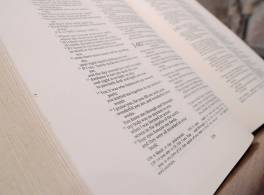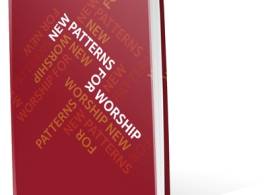Stories from the four churches
♥
At St Ann’s the Peace is the climax to which the first half of the service moves. Today the president uses a versicle and response echoing the theme of the service. This is used for a month or more during the same teaching theme or season of the Church’s year and is printed on the notice sheet. Members of the congregation are encouraged to greet one another with it outside the church – or even over the telephone! The response ‘and also with you’ is the signal for a lot of movement in the church as people shake hands, hug or greet one another in other ways. There is some sensitivity to people who want to remain on their own, though the PCC recently rejected a suggestion that one corner of the church be set aside as a peace-free zone. It is good to see people using the time to share with others something of what God has said to them through the preaching, and to discover what the younger members of the church have been doing in their groups. People have been taught what the Peace is for and how to use it (see here). At present they are experimenting with the Peace lasting for fifteen to twenty minutes, with refreshments being served, after which some who are not yet communicants leave. This has helped to encourage enquirers and those seeking baptism for their children, for instance, to experience a freer style of service which is shorter and does not commit them to receiving communion. Some, however, say that communion feels like an afterthought rather than the climax of the service. The service begins again with some gentle music and chorus singing, during which people take their seats as they prepare for the Thanksgiving.
♣
At St Bartholomew’s today the service has been led by one of the lay people. At the end of the intercessions she glances at her watch. The vicar is taking the service at one of the other churches in the group and often arrives here towards the end of the intercessions. If he does, it is natural for him to say the words of the Peace and it acts partly as a greeting announcing his arrival. But he must have met sheep on the road or have been talking too long at the other church, so the lay leader says the words of the Peace and the small congregation spend a few moments greeting one another. If they are short of time, the Peace can be briefer and more formal – living together in a village means they have already greeted one another today. Enter the vicar, at speed, just as the hymn is being announced. ‘Peace be with you all!’ he shouts, with a wave of the hand, and they all reply. Much better than ‘Good morning everyone’!
The clergy at St Christopher’s use a full range of seasonal introductory words to the Peace, occasionally following the pattern of the Maundy Thursday service in the seasonal material, using a short collect about peace instead of the introductory sentence. The deacon says, ‘Let us offer one another a sign of peace’ and sometimes wonders why people need this reminder what to do: why can’t they just get on with it? But when they were moving away from the (bad old?) days when the Peace was first exchanged in the sanctuary and then brought down to the people by a server greeting the person at the end of each row, these action words were needed to give people permission to move on their own. And occasionally they have the Peace later in the service, before the distribution. Some say that a general handshake is not appropriate at that point, so the ‘Let us offer …’ words are not used.
♠
The vicar at St Dodo’s is used to commanding his congregation, but has been having a battle over the Peace, with some resisting his attempts to make it more demonstrative. ‘We will all stand for the Peace. The peace …’ he bellows …‘We will all exchange a sign of peace.’ And when one couple on the front row remain kneeling (in peace), he marches over, lays a hand on each head and says, ‘The peace of the Lord be with you!’ which is not quite a demonstration of peace. There has never been any teaching on why or how to exchange the Peace (see section below). There is embarrassment as one lady, taught in a more formal church, extends both hands tentatively towards a large man bearing down on her with arms flung out ready to hug her. She ducks. In one corner, some of the younger people don’t seem to have been taught the difference between the Peace and snogging. And those who know one another well are engaging in noisy back-slapping and handshaking, ignoring those who are not known to them, who stand in sheepish silence waiting for the thing to be over. But that is the problem. The vicar is deep in (no doubt important) conversation with the church treasurer and has not thought how to announce the next hymn over the hubbub. So he shouts ….

What the Peace is for and how to use it
Some of the things people at St Ann’s have been taught:
* time to get straight with God before coming to communion (so you may need to be on your own, perhaps grappling with something from the sermon);
* time to get straight with other people before coming to communion (so you may need to go and make your peace, or ask forgiveness from someone at the other end of the church). This is what the Prayer Book calls being ‘in love and charity with your neighbours’;
* time to share with others something for prayer (so you may need to ask one of the leaders for the laying on of hands for healing, or some other individual ministry, later in the service);
* time to share with others something for praise (so you may have something that God has been doing with you during the week that will contribute to the praise of the whole church);
* time to greet people you do not know (so you may need to help someone else, perhaps someone new to the church, feel part of the Christian family at communion, rather than greeting only your close friends);
* time to be sensitive to the mood of others (so you may need to refrain from approaching someone who is clearly putting themselves right with God).

How to stop the Peace
Some suggestions:
* When announcing the Peace, announce the hymn after it: ‘At the end of the Peace we shall sing …’. Then all that is needed is a nod to the organist, or an agreement that the organist takes the decision when to start.
* The organist plays the opening bars of the hymn, and stops while the announcement is made.
* Some gentle music is played, perhaps a chorus which people can join in. As this ends the hymn is announced.
Note to the resources
Note 16 in Common Worship Holy Communion provides for the Peace to be used at other points than the one provided. It can be used as the opening greeting, or as part of the Communion rite before the breaking of bread or the Dismissal. The Peace may be introduced with a suitable sentence; some are provided in the seasonal provisions, and more here. The pattern is easy to copy, for instance to provide words for special occasions or to echo some particular teaching in the sermon. The introductory words should not normally be a prayer but an encouragement, based on Scripture, to minister peace to one another. The second sentence, ‘The peace of the Lord be always with you’, is best kept as a standard introduction to the response, but may be seasonally varied, as for example, ‘The peace of the risen Lord be always with you.’
Introductory words to the Peace
General
H1
God will speak peace to his people,
to those who turn to him in their hearts.
The peace of the Lord be always with you.
cf Psalm 85.8; 1 Samuel 12.20
General
H2
God has called us to live in peace.
The peace of the Lord be always with you.
cf 1 Corinthians 7.17
General
H3
The Apostle Paul said:
‘Aim for perfection,
be of one mind, live in peace.
Greet one another with a holy kiss.’
The peace of the Lord be always with you.
cf 2 Corinthians 13.11
General
H4
Let the peace of Christ rule in your hearts,
since as members of one body you are called to peace.
The peace of the Lord be always with you.
cf Colossians 3.15
General
H5
Blessed are the peacemakers:
they shall be called children of God.
We meet in the name of Christ and share his peace.
The peace of the Lord be always with you.
cf Matthew 5.19
General
H6
God is love
and those who live in love live in God
and God lives in them.
The peace of the Lord be always with you.
General
H7
‘Where two or three are gathered together in my name,’
says the Lord, ‘there am I in the midst of them.’
The peace of the Lord be always with you.
General
H8
We are all one in Christ Jesus.
We belong to him through faith,
heirs of the promise of the Spirit of peace.
The peace of the Lord be always with you.
H9
Jesus says to his disciples,
‘Peace I leave with you; my peace I give you.
Not as the world gives do I give to you.
Let not your hearts be troubled or afraid.’
The peace of the Lord be always with you.
cf John 14.27
Father, Son and Spirit
H10
Peace to you from God who is our Father.
Peace from Jesus Christ who is our peace.
Peace from the Holy Spirit who gives us life.
The peace of the triune God be always with you.
Christ’s coming
H11
In the tender mercy of our God,
the dayspring from on high shall break upon us,
to give light to those who dwell in darkness
and in the shadow of death,
and to guide our feet into the way of peace.
The peace of the Lord be always with you.
cf Luke 1.78,79
Christ’s coming
H12
May the God of peace make you completely holy,
ready for the coming of our Lord Jesus Christ.
The peace of the Lord be always with you.
cf 1 Thessalonians 5.23
Christ’s coming
H13
Blessed is the King who comes in the name of the Lord.
Peace in heaven and glory in the highest.
The peace of the Lord be always with you.
Incarnation
H14
Glory to God in the highest,
and peace on earth to all on whom his favour rests.
The peace of the Lord be always with you.
cf Luke 2.14
Incarnation
H15
Unto us a child is born, unto us a son is given,
and his name shall be called the Prince of Peace.
The peace of the Lord be always with you.
cf Isaiah 9.6
Incarnation
H16
Christ came and proclaimed the gospel,
peace to those who are far off
and peace to those who are near.
The peace of the Lord be always with you.
H17
Our Saviour Christ is the Prince of Peace.
Of the increase of his government and of peace
there shall be no end.
The peace of the Lord be always with you.
cf Isaiah 9.6,7
Cross
H18
Since we are justified by faith,
we have peace with God through our Lord Jesus Christ,
who has given us access to his grace.
The peace of the Lord be always with you.
cf Romans 5.1
Cross
H19
Once we were far off
but now in union with Christ Jesus we have been brought near
through the shedding of Christ’s blood,
for he is our peace.
The peace of the Lord be always with you.
cf Ephesians 2.13
Cross
H20
Jesus says: ‘Peace I leave with you; my peace I give to you.
Do not let your hearts be troubled, neither let them be afraid.’
The peace of the Lord be always with you.
cf John 14.27
Cross
H21
Christ is our peace.
He has reconciled us to God
in one body by the cross.
We meet in his name and share his peace.
The peace of the Lord be always with you.
cf Ephesians 2.15,16
Resurrection
H22
The risen Christ came and stood among his disciples
and said, ‘Peace be with you.’
Then were they glad when they saw the Lord. Alleluia.
The peace of the Lord be always with you.
cf John 20.19
Ascension
H23
Jesus says: ‘Peace I leave with you; my peace I give to you.
If you love me, rejoice because I am going to the Father.’ Alleluia.
The peace of the Lord be always with you.
Ascension
H24
The risen Lord now reigns at God’s right hand.
He is the Prince of Peace.
The peace of the risen Lord be always with you.
Holy Spirit
Christian beginnings
H25
We are baptized into Christ:
let us live in the Spirit of Christ.
The peace of the Lord be always with you.
Holy Spirit
H26
The mind of sinful nature is death;
the mind controlled by the Spirit is life and peace.
The peace of the Lord be always with you.
cf Romans 8.6
Holy Spirit
H27
God has made us one in Christ.
He has set his seal upon us and, as a pledge of what is to come,
has given the Spirit to dwell in our hearts. Alleluia.
The peace of the Lord be always with you.
cf Ephesians 1.13,14
Holy Spirit
H28
The fruit of the Spirit is love, joy, peace.
If we live in the Spirit, let us walk in the Spirit.
The peace of the Lord be always with you.
cf Galatians 5.22,23
Church and mission
H29
We are the body of Christ.
By one Spirit we were baptized into one body.
Keep the unity of the Spirit in the bond of peace.
We are bound by the love of Christ.
The peace of the Lord be always with you.
cf 1 Corinthians 12.13; Ephesians 4.3
Church and mission
H30
We are the body of Christ.
In the one Spirit we were all baptized into one body.
Let us then pursue all that makes for peace
and builds up our common life.
The peace of the Lord be always with you.
cf 1 Corinthians 12.13; Romans 14.19
Church and mission
H31
We are all one in Christ Jesus.
We belong to him through faith,
heirs of the promise of the Spirit of peace.
The peace of the Lord be always with you.
cf Galatians 3.28
Church and mission
H32
God has reconciled us to himself through Christ
and given us the ministry of reconciliation.
The peace of the Lord be always with you.
cf 2 Corinthians 5.18
Relationships and healing
Church and mission
H33
Jesus said:
‘Love one another.
As I have loved you,
so you are to love one another.’
The peace of the Lord be always with you.
cf John 15.12
Relationships and healing
Church and mission
H34
Let love be genuine. Never pay back evil for evil.
As far as it lies with you, live at peace with everyone.
The peace of the Lord be always with you.
cf Romans 12.9,17,18
Relationships and healing
Church and mission
H35
To crown all things there must be love,
to bind all together and complete the whole.
Let the peace of Christ rule in our hearts.
The peace of the Lord be always with you.
cf Colossians 3.14,15
Living in the world
H36
God calls us to peace:
in God’s justice is our peace.
Christ calls us to be God’s people:
in Christ is our peace.
The peace of the Lord be always with you.
cf Ephesians 2.14,15
Living in the world
H37
Blessed be Christ, the Prince of Peace.
He breaks down the walls that divide us:
praise Christ who is our peace!
The peace of the Lord be always with you.
Living in the world
Christ’s coming
H38
Peacemakers who sow in peace raise a harvest of
righteousness.
The peace of the Lord be always with you.
cf James 3.18
Holy Communion
H39
The kingdom of God is not a matter of eating
and drinking,
but of righteousness, peace and joy in the Holy Spirit.
The peace of the Lord be always with you.
cf Romans 14.17
Heaven
H40
We are fellow-citizens with the saints and of the household of God,
through Christ our Lord, who came and preached peace
to those who were far off and those who were near.
The peace of the Lord be always with you.
cf Ephesians 2.17,19
H41
May the God of peace sanctify you:
may he so strengthen your hearts in holiness
that you may be blameless before him
at the coming of our Lord Jesus with his saints.
The peace of the Lord be always with you.
cf 1 Thessalonians 5.23; 3.13
Heaven Christ’s coming
H42
May the God of peace make you perfect and holy,
that you may be kept safe and blameless
in spirit, soul and body,
for the coming of our Lord Jesus Christ.
The peace of the Lord be always with you.
cf 1 Thessalonians 5.23
New Patterns for Worship, material from which is included here,
is copyright © The Archbishops' Council 2002 and published by Church House Publishing.


